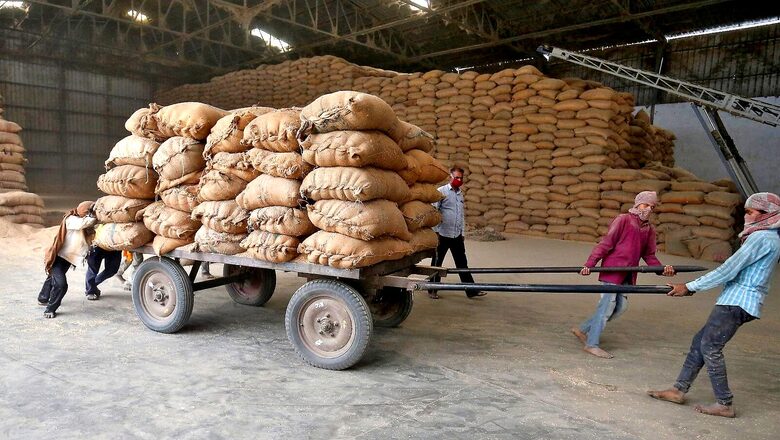
views
The Centre on Saturday India’s ranking at 107 in the Global Hunger Index 2022 is an “erroneous measure of hunger” and pointed at serious methodological issues, adding the report was part of a consistent effort to taint the country’s image “as a Nation that does not fulfill the food security and nutritional requirements of its population.”
The Global Hunger Report 2022, released by Concern Worldwide and Welt Hunger Hilfe, both non-government organisations from Ireland and Germany, published a score of 29.1, the level of hunger in India was labelled “serious”. India ranked 107 out of 121 countries in the Global Hunger Index 2022 with its child-wasting rate at 19.3 per cent, being the highest in the world.
The Ministry of Women and Child Development in a statement said, “A consistent effort is yet again visible to taint India’s image as a nation that does not fulfil the food security and nutritional requirements of its population. Misinformation seems to be the hallmark of the annually released Global Hunger Index.”
The government noted three out of the four indicators used for the calculation of the index are those related to the health of children and “cannot be representative of the entire population.” “The fourth and most important indicator estimate of Proportion of Undernourished (PoU) population is based on an opinion poll conducted on a very small sample size of 3000,” it said.
ALSO READ | India Ranks 107 Out of 121 In Global Hunger Index: How is the Ranking Calculated & What ‘It Indicates’
According to the official website of the index, data for GHI scores are derived from various UN and other multilateral agencies. The GHI scores are based on the most recent revised data for each of the four indicators: undernourishment, child stunting, child wasting and child mortality. Estimates for the GHI component indicators are made based on the most recent available data where original source data is unavailable.
The report lowers India’s rank based on the estimate of Proportion of Undernourished (PoU) population for India at 16.3%, the ministry explained. “The data collected from a minuscule sample” through Food Insecurity Experience Scale (FIES) was “used to compute PoU value for India which is not only wrong and unethical, it also reeks of obvious bias.” The publishing agencies of the Global Hunger Report, Concern Worldwide and Welt Hunger Hilfe, have evidently not done their due diligence before releasing the report, it said.
The ministry in its latest statement noted that the report was “disconnected from ground reality” and “deliberately” ignored efforts made by the government to ensure food security for the population, especially during the Covid-19 pandemic. “Taking a one-dimensional view, the Centre said the report lowers India’s rank based on the estimate of Proportion of Undernourished (PoU) population for India at 16.3 per cent,” it said.
The matter has been taken up with the Food and Agriculture Organization (FAO) not to use such estimates based on FIES (Food Insecurity Experience Scale) survey module data in July 2022 as the statistical output of the same will not be based on merit, it added.
“Though an assurance was forthcoming that there will be further engagement on this issue, the publication of the Global Hunger Index report irrespective of such factual considerations is regrettable,” the ministry said.
Flagging the questions asked during the survey, the Centre said, “it is evident such questions do not search for facts based on relevant information about the delivery of nutritional support and assurance of food security by the government.”
“The per capita dietary energy supply in India, as estimated by FAO from the Food Balance Sheets, has been increasing year-on-year owing to enhanced production of major agricultural commodities in the country over the years and there is absolutely no reason why the country’s undernourishment levels should increase,” the government said.
The Centre listed its various initiatives for food security during the pandemic including foodgrain distribution for beneficiaries of the National Food Security Act (NFSA), PM Garib Kalyan Anna Yojana (PM-GKAY); steps undertaken by state governments; supplementary nutrition to children, pregnant women and lactating mothers under Anganwadi Services; supplementary nutrition distribution by Anganwadi Workers and Helpers; wage support and nutritious food during pregnancy and post-delivery period under Pradhan Mantri Matri Vandana Yojna.
The ministry said the three other indicators apart from PoU, included in Global Hunger Index relate primarily to children viz. stunting, wasting and under 5 mortality.
“These indicators are outcomes of complex interactions of various other factors like drinking water, sanitation, genetics, environment and utilisation of food intake apart from hunger, which is taken as the causative/outcome factor for stunting and wasting in the GHI. Calculating hunger based on mainly indicators relating to health indicators of children is neither scientific nor rational, it said.
Read all the Latest News India and Breaking News here




















Comments
0 comment